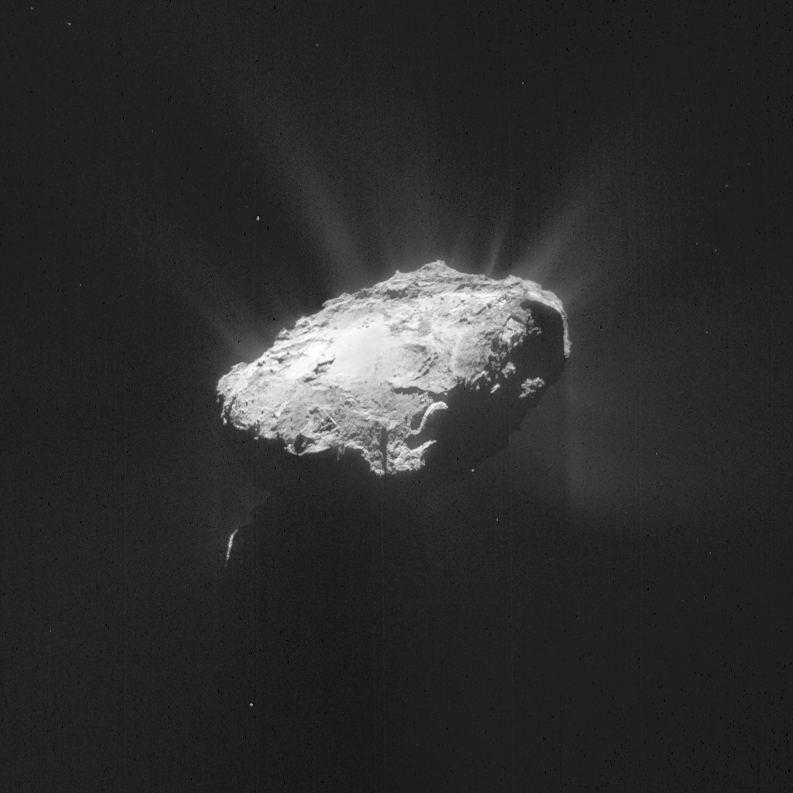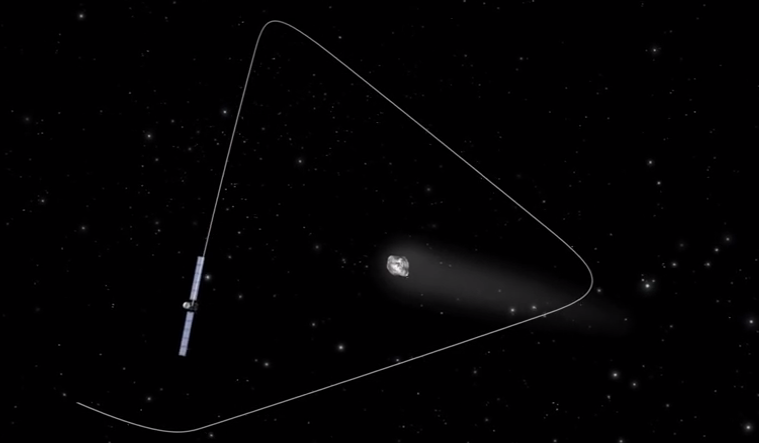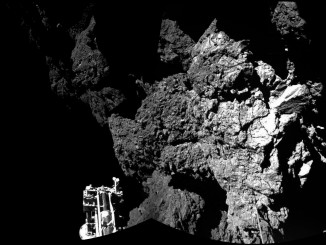
Mission controllers are rethinking a series of close-up comet flybys planned for Europe’s Rosetta spacecraft after a haze of dust around the comet’s central nucleus led to navigation errors during a close encounter in late March.
Rosetta’s computer put the spacecraft into safe mode in the aftermath of a March 28 flyby of comet 67P/Churyumov-Gerasimenko. Star trackers aboard the solar-powered probe were unable to lock on to guide stars, confusing the craft’s navigation system and causing Rosetta’s communications antenna to drift off alignment with Earth.
Ground teams blamed the glitch on dust particles around the comet’s nucleus. The guidance system confused the flecks of dust for stars, rendering the star trackers unable to set a navigation fix.
Rosetta is supposed to track the locations of bright stars to determine which way it is pointing in space.
The spacecraft defaulted into safe mode, a standby configuration where Rosetta switches off its science instruments and halts non-essential functions to ensure the probe’s survival.
Rosetta’s maneuvering capabilities were curtailed when the spacecraft was in safe mode, causing the orbiter to fly away from the comet on an escape trajectory, reaching a distance of about 400 kilometers (248 miles). A pair of thruster burns put Rosetta back on a course closer to the comet, and it arrived at a point 140 kilometers (87 miles) by April 8.
But plans for further close-up encounters with the comet’s irregular-shaped nucleus have been postponed for now.
“This has ultimately meant a complete replanning of the upcoming flyby trajectories,” said Sylvain Lodiot, Rosetta spacecraft operations manager, in a post on a European Space Agency website. “We’re first moving to a terminator orbit at a distance of 140 kilometers and then we’re targeting 100 kilometers (62 miles). Then we will adopt a similar strategy to when we first approached the comet in August last year. That is, we will fly ‘pyramid’ trajectories, starting at about 100 kilometers on April 11, and we’ll monitor how the spacecraft reacts before moving closer.”

Rosetta will complete three pyramid-shaped laps around comet 67P’s rocky core through the end of April, but officials are wary of sending the spacecraft closer to the comet. Ground teams want to monitor the growing cloud of dust and vapor around the comet before deciding the mission’s long-term trajectory.
The March 28 encounter took Rosetta about 14 kilometers (8.7 miles) from the comet’s surface, following up on a 6-kilometer (3.7-mile) flyby in February.
Before Rosetta ran into problems March 28, the mission plan called for the craft to conduct similar close approaches to the comet over the coming months, including a targeted flyby through one of the comet’s jets launching water vapor and other materials into space.
Scientists expect the comet to spit off more material as its orbit swings closer to the sun. Heat from the sun is making the hibernating comet come alive, triggering plumes and expanding the tiny world’s coma, the fuzzy cloud often seen in telescopic views of comets.
Comet 67P will be nearest to the sun Aug. 13, and experts predict the comet to reach maximum activity in September.
“We’re now assessing the impact of the new trajectory scheme on the planned science observations for the months ahead, including those which anticipated close flybys,” said Matt Taylor, Rosetta’s project scientist, in a statement on ESA’s website. “Our science operations team at ESAC is extremely busy working with the instrument teams to optimize science observations and associated spacecraft pointing for this new scheme. As we move forward, we will analyze what can be modified and improved in order to maximize science return within the capabilities of the spacecraft. We will be looking at examining all options to mitigate the issues we had and recover some of the science goals.”
Ground controllers expected they may have to adjust Rosetta’s flight plan due to growing activity at the comet. Another concern with Rosetta’s close flybys involves drag and impacts on the spacecraft’s wide-spanning solar panels, but those issues have — so far — proven less serious than the star tracker miscue.
Meanwhile, Rosetta was scheduled to begin another listening campaign Sunday to monitor for radio signals from the Philae lander dropped to the comet’s nucleus in November. Scientists last heard from the landing craft two days after it touched down in November, but they hope Philae will recharge its batteries in the coming months as the probe receives more sunlight.
“The communication unit on the orbiter will be turned on around the clock,” said Stephan Ulamec, manager of the Philae lander team at DLR, the German space agency.
“Most likely, Philae will wake up in May or June, but we don’t want to miss the moment if it should have enough energy and a sufficiently high operating temperature to wake up earlier,” Ulamec said in a blog post on ESA’s website.
Follow Stephen Clark on Twitter: @StephenClark1.



